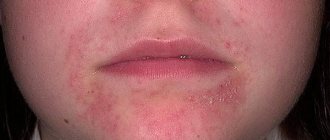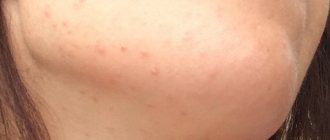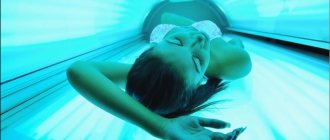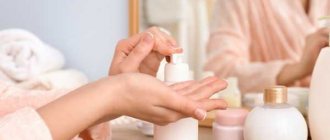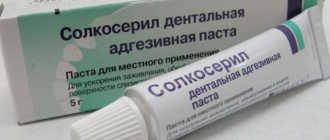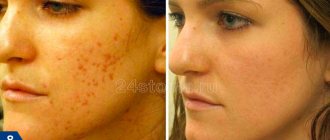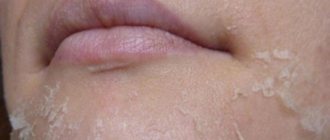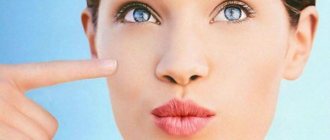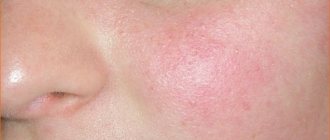Our skin always needs careful care, especially in the facial area. This zone reflects our state of health. This is what Chinese medicine has been saying for thousands of years. Not all of us can boast of perfect skin. Acne and various rashes occur often during adolescence, but go away over time. In adults, you can also notice a rash on the skin of the face, which is immediately alarming. What are the causes of such rashes and how are they related to health?
Classification of rashes
- A rash in the forehead area is most often accompanied by severe itching, but sometimes it can occur latently, without acute symptoms. It comes in red, white, purple or silver. As a rule, the appearance of rashes is accompanied by dermatitis and inflammatory diseases.
- According to their structure, rashes on the forehead can be flat, embossed, scaly and uneven. In the form of spots, dots, spreading over different parts of the body. In addition, it can peel and flake off.
- In severe cases, an allergic rash on the skin of the forehead may be accompanied by swelling of the facial area and tongue, and difficulty breathing. This condition is very dangerous for the patient and is called anaphylaxis. If such symptoms appear, emergency treatment is required.
- If the rash on the forehead is characterized by purple spots, accompanied by fever and stiffness of the neck muscles, it is necessary to exclude the development of bacterial meningitis in the patient.
Rash on the forehead of infectious etiology
Since the pathogenesis of the bacterial nature of the rashes is clear, let’s move on to rashes of viral etiology.
- The appearance of bright red elements on the forehead with a diameter of up to 3 - 4 mm in rubella and pinpoints in measles begins childhood infections that occur in adulthood.
- With chickenpox, the first itchy blistering elements appear on the head, in the hair growth area and near its border on the forehead. Until a typical clinical picture is formed, that is, until the rash spreads throughout the body, diagnosing the disease is quite problematic.
- It is difficult to independently recognize herpes zoster (shingles), which occurs as a result of delayed reactivation of the chickenpox virus in an adult. The first of all symptoms of a viral attack is a tingling, blistering rash on the forehead. Only the signs of inflammation of the eyeball that appear after them make it possible to determine the diagnosis.
Causes of rash in adults
The main cause of a rash on the forehead is an allergic reaction.
Sometimes such symptoms are not associated with allergies and can result from disturbances in the functioning of the pancreas and liver. Often a rash appears with rheumatoid diseases.
In this case, allergens can be both food and animals, and clothing. Therefore, if a pinpoint hyperemic rash on the forehead is detected, a mandatory consultation with an allergist is necessary.
Of no small importance is the genetic predisposition to allergies, both the general reaction of the body and increased sensitivity to a specific allergen.
In patients, rashes on the forehead are possible after contact with local antiseptics. In this case, it is necessary to eliminate the causes of the allergy. In addition, it is strictly not recommended to remove the rash on the forehead using physical methods. This can lead to infection and worsen the situation, especially in a child.
The causes of the disease may appear due to hormonal disorders, dysbacteriosis and malfunctions of the liver, pancreas and gall bladder.
In addition, errors in diet can provoke rashes. In this case, it is necessary to review the diet, excluding highly allergenic foods (coffee, tea, chocolate, sweets, etc.). It is preferable to choose a drink in the form of freshly squeezed juices, mineral or ordinary distilled water.
Localization
Acne on the face of men can appear on various areas of the skin. In maximum concentration they can accumulate in the following areas:
- On the forehead.
- On the temples.
- On the bridge of the nose.
- On the nose.
- Around and under the eyes.
- On the cheeks.
- On the chin.
- Around the lips.
- On the neck.
According to one theory, the abundant appearance of rashes on a limited area of facial skin may indicate damage to a certain internal organ.
However, if acne is isolated, then most likely its occurrence is associated with non-compliance with personal hygiene rules or with the use of inappropriate cosmetics.
Why do they appear on the forehead?
In Eastern medicine, it is generally accepted that any rash on the skin of the face is a sign of damage inside the human body. There is a map of acne, according to which each area reflects disturbances in the functioning of one or another organ.
There are the following areas on the forehead where heavy rashes may appear:
- Hairline. The predominant localization of acne in this area may indicate damage to the gallbladder.
- Center of the forehead. The appearance of acne in this area can be a kind of “signal” about problems with the intestines. Their location on the upper part of the forehead is typical for lesions of the large intestine, and on the lower part for the small intestine.
- Above the eyebrows. Rashes in this area are often associated with problems with the heart.
- The area located below the central part of the forehead and above the superciliary area reflects normal bladder activity.
For the most part, rashes on the forehead may indicate the presence of lesions in the digestive system. Therefore, if acne does not disappear for a long time and tends to spread, you should immediately seek medical help from a gastroenterologist.
Causes of rashes in children
In infants, allergies can appear suddenly and a similar manifestation in a child can be provoked by both external and internal factors. Any appearance of a rash (especially in the forehead area) requires finding out the cause of the disease in the infant.
In a newborn baby, an allergic rash may appear as a result of an allergy to mother's milk if the woman's nutrition is impaired. Food allergies are one of the most common causes of forehead rash.
The skin of a newborn is very delicate and susceptible to external influences, so a baby may develop an allergy to synthetic items from which clothes are made. In addition, allergies can occur upon contact with washing powders, baby detergents, animal hair, etc. In this case, it is necessary to switch to hypoallergenic cosmetics, completely eliminating contact with allergens.
Quite often, pinpoint hyperemic rashes in infants can occur due to prickly heat, when the surface layer of the child’s skin comes into contact with wet underwear for a long time, resulting in skin irritation.
In case of infectious diseases, a hyperemic rash on the baby’s forehead may be accompanied by an increase in temperature, lethargy of the child, refusal to eat, and increased drowsiness.
The occurrence of a rash in a child should alert parents. Red spots, flaky skin and irritation are quite easy to notice in a baby. In addition, the development of Quincke's edema (giant urticaria) is possible. This condition is a serious complication that is observed quite rarely, but is quite difficult, especially for infants, and can lead to respiratory arrest due to swelling spreading to the larynx. If this complication is suspected, the child must be hospitalized immediately.
Treatment
Any allergy requires specific treatment after mandatory consultation with an allergist and dermatologist. To obtain a positive result, the causes of the disease are first determined.
In addition to limiting interaction with allergens, drug therapy may be prescribed, consisting of the following medications:
First generation antihistamines (Tavegil, Suprastin, Diazolin) and the most modern antiallergic drugs with prolonged action (Claritin, Zodak). Treatment of infants is carried out strictly under the supervision of the attending physician.
Symptoms of the disease in a child must be neutralized with the help of a hypoallergenic diet, which is used in combination with the treatment of liver diseases, gall bladder and dysbiosis. Quite often, such diseases can cause an allergic rash on the forehead.
Enterosorbents have a positive effect in the treatment of allergic symptoms in adult patients and children. They are prescribed to remove toxic substances from the body that are formed as a result of exposure to an allergen. These include Enterosgel. Polysorb, activated carbon, etc.
In addition to antihistamines and enterosorbents, medications in the form of ointments and gels can be prescribed. These include Fluorocort ointment, Fenistil. In addition, glucocorticosteroids (hydrocortisone, prednisolone, etc.) may be prescribed. However, it should be borne in mind that the dosage is selected individually for adult patients and children.
Effectively relieves allergy symptoms with a product for external use - La-Cri. This gel neutralizes itching, skin hyperemia, swelling, flaking, promoting healing and restoration of damaged skin. Its advantage is its neutral effect on the baby's skin.
How to get rid of it?
To completely eliminate unpleasant skin rashes, it is necessary to find out and eliminate the causes that led to their appearance.
When dealing with acne, it is very important to adhere to the following principles:
- Maintain proper, healthy nutrition. Eat as little fatty, sweet foods and foods that contain large amounts of simple carbohydrates as possible.
- Maintain personal hygiene. It is necessary to ensure that the surface of the skin of the face and hands is clean; be sure to wash your face in the morning and evening hours. However, it is worth remembering that too frequent water treatments can dry out the skin and weaken its protective function.
- Regularly use antiseptic creams.
- Do not squeeze pimples. Such actions are fraught with the spread of infection into the deep layers of the epidermis and aggravation of the inflammatory process.
- Do not cleanse your skin with alcohol lotions. These cosmetics irritate the sebaceous glands and increase their secretion.
- Do not expose the skin to the active influence of solar radiation, as it increases the production of sebum.
If acne was caused not just by poor diet or lack of personal hygiene, but by hormonal imbalance or disorders of the internal organs, then just following these rules will not be enough for recovery. In such cases, specialists often prescribe drugs with local or even systemic action.
On the face
If the occurrence of acne is associated with hormonal imbalance, for mild acne it is enough to use topical symptomatic medications.
The most popular are:
- Skinoren gel.
- Differin gel.
- Baziron gel.
- Curiosin gel.
Heavy rashes on the skin can be dried using simple tar soap, as well as calendula tincture. For disinfecting, cleansing and preventing inflammation, local antiseptics are used - Ichthyol ointment, Metrogyl gel.
In cases where acne has 3-4 degrees of severity, systemic therapy is prescribed, which consists of using antibacterial (Bactroban ointment, Fusiderm cream, Zinerit in powder form, Levomikol ointment) and hormonal agents (Hydrocortisone ointment and its analogues).
They should be used carefully, according to the instructions and only as prescribed by the attending physician.
On the body
Acne in men can appear not only on the face, but also on various parts of the body - back, chest, arms. For mild acne, it is enough to adhere to a healthy diet, good personal hygiene and treat the skin surface with products that contain salicylic acid or benzoyl peroxide, as well as cosmetics based on glycolic or lactic acids.
For moderate to severe acne, the help of a specialist is necessary. In severe cases, Isotretinoin may be prescribed. The drug has a large number of side effects, so using it on your own is strictly prohibited. Other retinoids and antibiotics may also be prescribed.
Prevention
To prevent rashes on the forehead and face, as well as to prevent its spread and the development of all kinds of complications, the following actions must be avoided:
- allergies on the face require mandatory consultation with an allergist;
- Under no circumstances should you wipe the rash with an alcohol-containing solution, especially if the rash appears in a child;
- You cannot take medications on your own without first being examined by a specialist;
- It is not recommended to smear the forehead with greasy ointments and creams;
- If a rash occurs, you can take baths with a decoction of chamomile and string. These herbs have good antiseptic and anti-inflammatory properties, disinfecting the site of the rash. You can dip a clean napkin into the freshly prepared solution, wring it out and wipe the area of the rash;
- It is necessary to monitor the temperature and humidity in the room, especially if the baby has an allergy. To avoid scratching and infection, it is necessary to trim your baby’s nails in a timely manner.
It must be remembered that an allergy on the forehead, in any of its manifestations, can be complicated by secondary diseases, accompanied by severe complications, so self-treatment is strictly prohibited!
It is important to consider that allergies in the facial area appear quite often, especially in children, so it is necessary to identify all the causes of the disease and carry out the necessary medical treatment. In the case when the rash is not accompanied by complications and provided that all the recommendations of the attending physician are followed, the rash on the forehead quickly disappears, leaving no consequences.
Before starting any intervention in the body, it is necessary to consult a specialist who will perform a series of laboratory tests to identify the etiology of the disease and prescribe adequate treatment.
More than 10% of men over the age of 25 have acne. These pimples are no different from teenage acne. Similarly, in adult men, the cause of acne on the forehead is the excess secretion of sebum in the sebaceous glands, caused by high levels of hormones. In turn, increased production of sebum becomes an ideal environment for the proliferation of bacteria and the development of inflammation.
The appearance of acne in adulthood
The formation of various skin rashes only in rare cases depends on the person’s age. To determine the cause after 30–50 years, you need to dig deeper. The condition of the skin is influenced by the work of the gastric tract. Taking medications and eating certain foods can also cause acne. Basic lack of personal hygiene is another reason that can cause skin rashes. Of course, one pimple is unlikely to cause panic, but only if it did not pop up on the eve of an important event. What can I do to make a pimple go away overnight? Today, there are some topical medications that will help get rid of it in a few hours. Poor nutrition, poor sleep, psycho-emotional stress and stress - all this also provokes improper functioning of the sebaceous glands. You can deal with one or two pimples on your own, but focal rashes, which are almost impossible to get rid of, require a visit to a dermatologist, who will help identify the true cause based on the patient’s individual testimony.
Adult men are not so painfully worried about the formation of acne on the face or the appearance of boils in the most unpredictable places. This problem should not be ignored; you should consult a doctor.
ACNE ON THE FOREHEAD IN MEN: REASONS
What causes acne on the forehead in adult men? There are several main reasons.
Stress causes a sharp temporary increase in levels of androgens and the hormone cortisol, which stimulates the sebaceous glands to produce excess sebum. With chronic tension or moments of acute stress, the condition of the skin can worsen.
- Hormones
Hormones are one of the main causes of forehead acne in men. Hormonal imbalances can trigger acne. The powerful androgen testosterone is responsible for increasing sebum production starting in adolescence. Its excess, caused by hormones, can clog pores, leading to the development of acne on the forehead, nose, back, neck and scalp in adult men. Acne-causing bacteria are present on everyone's skin, but when there is overproduction of sebum oil, it creates an ideal environment for bacteria to grow and multiply.
Genetic predisposition is also considered one of the main reasons why men may develop acne on their forehead and face in adulthood. It is suggested that genetic factors are a more likely cause compared to diet and environmental factors.
- Excessive dry skin
Many acne-fighting products dry out the skin. This causes the sebaceous glands to work harder and produce even more sebum to soften the skin. This again can lead to clogged pores and breakouts.
- Chemicals in cosmetics
Facial products can irritate men's skin, causing inflammation that leads to acne. Hair products, shampoos, sprays, gels that get on the skin can also block pores.
- Dandruff and oily scalp
Dandruff and excess oil production can clog skin pores, causing acne. Dandruff is one of the most common causes of forehead acne in men. People with oily scalps are also more likely to develop acne on their neck, hair, and upper back.
- Excessive cleansing of facial skin
Too frequent washing with aggressive products, as well as excessive use of scrubs, can lead to irritation, flaking, increased sensitivity, disruption of the natural balance of the skin and, as a result, acne.
- Closed pores and oily skin type
Lack of cleansing can also cause acne. If skin cells are regenerating too much and a lot of sebum is being produced, pores can quickly become clogged and blocked. Without cleaning, they can become inflamed and turn into pimples.
Some foods, such as dairy and carbohydrates, can affect hormonal levels (especially insulin and IGF-1), which in turn can lead to acne.
Pimples on the forehead in men can appear due to constant friction (for example, from a hat), lack of hygiene, excessive sweating, taking medications (steroids, hormonal drugs, barbiturates), and in some people they develop after prolonged exposure to the sun.
Treatment of male acne
Treatment of acne in men should be systematic. During therapy, topical agents, oral tablets, and hardware technologies are used. It is also very important to adjust your daily routine and diet and carefully care for problem areas.
Local remedies
Products for external use include pharmaceutical gels and lotions, or natural creams created on the basis of organic components.
Baziron AS
Gel designed to combat comedones and inflamed acne – Baziron AS.
Benzoyl peroxide, the active ingredient of the drug, allows a man to:
- Reduce the amount of inflammation;
- Reduce secreted fat;
- Destroy pathogenic microbes;
- Activate blood microcirculation;
- Prevent acne progression;
- Cleanse your face of dead epithelial cells.
The course of gel treatment is 3 months, the frequency of use is twice a day. Contraindications include only individual intolerance.
Intraskin
A natural remedy for getting rid of acne. The formula contains chamomile and rosemary hydrolates, D-panthenol, azelaic acid.
The effect of the product is:
- Regulating the secretion of sebaceous secretions;
- Reducing inflammatory processes;
- Elimination of skin irregularities;
- Activation of cellular metabolism.
For mild acne, the cream should be applied to the face once a day, for severe acne - twice. The duration of therapy is at least a month. The organic composition of the product allows it to be used without restrictions; the only obstacle can be hypersensitivity to the components in the composition.
Zenerite
The lotion is designed to combat purulent inflammation and comedones due to disruption of the sebaceous glands. Zinerit contains 2 active components - erythromycin and zinc acetate.
Due to this drug:
- Stops the inflammatory process;
- Dissolves plugs in pores;
- Dries out pustules;
- Destroys germs;
- Prevents possible complications;
- Reduces potholes and scars.
A man’s facial treatment should be carried out morning and evening for 3 months. Apart from hypersensitivity, the lotion has no contraindications, but side effects such as redness, burning, itching and decreased local immunity are possible.
Systemic drugs
Systemic oral medications are necessary in severe stages of acne, accompanied by extensive skin lesions and multiple ulcers.
Antibiotics
Taking antibiotics is recommended for moderate acne for a comprehensive fight against bacterial infection. The most popular drugs in dermatology are the tetracycline group and lincosamides.
Doxycycline, a member of the tetracycline series, is a new generation antibiotic that affects the body, effectively destroying pathogenic microorganisms and quickly accumulating in the sebaceous glands. The dosage and duration of the course are prescribed by the attending physician. It is very important to follow the rules when treating with doxycycline:
- Refrain from physical therapy, laser treatments, solarium and sunbathing:
- At the same time, do not use systemic retinoids, diabetes medications, psychotropic and anticonvulsant medications.
ACNE ON THE FOREHEAD IN MEN: TREATMENT
Proper cleansing is the first step in treating forehead acne in adult men, even if the inflammation is not caused by dirt. This includes keeping pores open and gently removing dead skin cells. Cleaning should be gentle and careful so as not to worsen the condition.
To cleanse and moisturize the skin, it is better to use non-comedogenic cosmetics labeled non comedogenic or non-acnegenic. It is advisable that face washes and creams do not contain fatty oils.
Mild to moderate acne can be treated with over-the-counter topical treatments. These medicines may contain:
- benzoyl peroxide (Baziron, etc.),
- salicylic acid,
- sulfur
- zinc (products for external or internal use),
- azelaic acid (Skinoren),
- antibiotics (Zerkalin, Zinerit),
- glycolic, lactic or fruit acids,
- adapalenes (Differin, Clensite),
- isotretinoin (Retasol).
It may take up to six weeks of use for the medicine to start working. If after 2-3 months there are no positive changes, the doctor may prescribe another treatment regimen.
Natural remedies for forehead acne include:
- aloe juice,
- lemon juice,
- tea tree essential oil,
- masks made of natural clay.
In case of severe acne, medications for internal use are usually prescribed: antibiotics and/or isotretinoin tablets. A dermatologist can also prescribe a course of hardware procedures: laser treatment of acne, phototherapy, peelings.
Causes
The most common causes of small pimples on the forehead are:
1. Excess sebum.
2. Failure to comply with hygiene rules. This is not only a lack of removal of dirt from the face, but also washing too often and excessive use of cleansers.
3. Cosmetics. It can cause small acne if it is not chosen according to your skin type or age. In addition, cosmetics that have expired should not be used at all.
4. Poor nutrition.
Overeating, insufficient food intake, consumption of the following foods:
- carbonated drinks;
- fast food;
- sweet food;
- salty food;
- spicy food (causes rashes, most often on the forehead).
5. Taking medications. Small pimples on the forehead that look like a rash occur when you take antibiotics or take certain vitamin supplements.
6. Diseases of organs CT.
